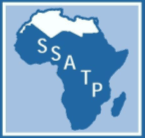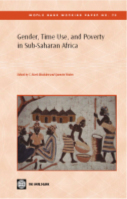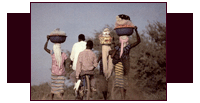|
|
Introduction to the Guide
Page 1 of 1
Gender and Transport Resource Guide: Introduction
The purpose of this Resource Guide is to provide easy
access to useful materials on Gender and Transport. The CD-ROM version
makes them available to people without internet access as well. We hope
providing broad access to these materials will help to sustain efforts
to mainstream gender in the transport sector and ultimately enhance the
impact of sector investments. As transport sector objectives expand to
include poverty reduction and the MDGs as well as economic growth, it
is essential that policy makers, practitioners and researchers build on
the existing knowledge base to reach their targets.
The materials included here provide practitioners in the transport sector
with guidance and background materials directed at answering the questions
of "Why?" and "How to?" support gender mainstreaming in the sector. The
Resource Guide:
-
Provides checklists, entry points, and tools for mainstreaming
gender in transport projects and policies.
-
Brings together case studies, best practices, training manuals,
tools and reports on gender and transport from the Gender and Rural
Transport Initiative (GRTI), and other initiatives of the World
Bank and allied agencies.
-
Uses a gender lens to analyze transport programs ranging from
national infrastructure policies and plans to community driven
development projects.
-
Presents examples of engendering the full range of transport
network interventions ranging from intermediate means of transport
(IMT) such as bicycles, donkeys and carts to formal transport
sub-sectors such as roads, buses and boats.
-
Provides slide presentations that can be adapted for gender
and transport training, gender sensitization, and other events.
|
click the links to show/hide details
Intended Users of the Resource Guide
This guide provides gender mainstreaming tools and information for
individuals and groups working on policy, design, implementation,
monitoring and evaluation, capacity building and research in the
transport sector and sectors affected by transport. Different users
of the guide will find the following sections most relevant:
Policy makers
Decision making can be improved by using:
|
Practitioners
Modules that can assist practitioners in planning and implementing sustainable,
inclusive transport projects:
|
Researchers, evaluators
Will find data, methodologies, and secondary sources in:
-
GRTI country reports.
-
Promising approaches, particularly case studies.
-
Appraisal tools.
-
Monitoring and evaluation tools.
-
Resource documents such as:
-
Technical Reports
-
Reference Lists
-
Conference Reports
|
Trainers, facilitators
Trainers can build capacity in gender and transport using materials included in the guide:
|
|
click the links to show/hide details
Overview of the Sections of the Guide
Module 1: Why Gender and Transport?
Provides the rationale for addressing gender issues in rural and
urban transport policies, programs and projects.
-
Photos and bullet points make the case based on time use analysis,
case studies, and multi-sectoral synergies.
-
Demonstrates interface between gender, transport and poverty,
HIV/AIDS, maternal mortality, and access to education.
-
Shows how gender-integrated transport programs can contribute to
achieving the Millennium Development Goals [MDGs]
- PowerPoint version is available in Module 6 for use
in gender and transport workshops, briefings, conferences
or gender sensitization sessions.
- Links to brief source documents that provide more
details on these issues.
|
Module 2: Challenges for Mainstreaming Gender in Transport
Highlights
key gender-related constraints in travel and transport that
need to be addressed in transport policies, strategies,
programs and projects.
- Notes misperceptions about gender and transport.
- Examines women and girls' time poverty worldwide.
- Looks at key constraints on women and girls' travel,
access to transport and employment in transport.
- Considers the social and economic costs of limited
access for women and girls.
- Notes transport issues of the youth and the elderly.
- Highlights gender-related issues for resettlement.
- Links to in-depth source documents for more information.
- A PowerPoint version of this module is available (in
Module 6) for use in workshops, briefings and conferences.
|
Module 3: Promising Approaches for Mainstreaming Gender in Transport
Presents effective, field-tested project, program and policy interventions.
- Illustrative examples of mainstreaming gender in
projects drawn from World Bank, IFRTD, CIDA, DFID and
other programs.
-
Gender informed transport planning.
-
Gender-responsive IMTs and other means of saving labor.
-
Women's employment in road works.
-
Mobilization and advocacy.
-
Engendering organizational structures.
-
Mainstreaming gender in transport policy.
-
Multi-sectoral approaches.
-
Empowerment through information communication technology (ICT).
- A PowerPoint version of this module is available
(in Module 6) for use in workshops, briefings and conferences.
|
Module 4: The Gender and Rural Transport Initiative (GRTI)
- Describes the evolution of GRTI in the context of
the Sub-Saharan Africa Transport Policy Program.
- Presents the objectives of GRTI.
- Summarizes the approaches of GRTI.
- Highlights key components of GRTI.
- Pilot projects.
- Gender studies.
- Country workshops.
- Capacity building services.
- Awareness raising and information dissemination.
- Highlights key points of reports on 16 country activities.
- Features promising practices and key findings in
reports
- Summarizes recommendations for next steps needed.
- Can be adapted and used as material for slide presentations
in workshops, briefings and conferences
- Provides links to:
- GRTI Summary Country Reports
- GRTI Technical Reports
- GRTI Good Practice Notes
- GRTI Training Material
|
Module 5: Tools for Mainstreaming Gender in Transport
Offers a variety of "how to" guidelines and tools for mainstreaming
gender in transport policies, strategies and projects.
-
Provides guidelines and checklists for key entry points for
mainstreaming gender in transport.
-
Describes the evolution of GRTI in the context of the Sub-Saharan
Africa Transport Policy Program.
-
Policy level entry points (macro and sectoral).
-
Project level entry points.
-
Tips on effective techniques and approaches for integrating gender
in transport:
-
Training/capacity building.
-
Participatory approaches.
-
Communication strategies.
-
Advocacy and mobilization.
-
Links to documents such as tools and handbooks that provide more
detailed instruction on how to mainstream gender in different aspects
of transport and in the interface of transport with poverty reduction,
HIV/AIDS prevention, and lowering maternal mortality rates.
|
Module 6: Resources for Mainstreaming Gender in Transport
Module 6 provides hyper-links to a wide range of materials
organized by type, each of which is divided into sub-topics.
Documents and other materials include:
-
Web sites and discussion groups: addressing gender and transport issues.
- Issues and strategy papers: brief
documents providing rationale for addressing various
topics in gender and transport, and strategies to do
so.
-
Case studies: country-specific detailed analyses of gender and transport access
and interventions.
- Toolkits and guides: documents that
provide step-by-step, "how-to" guidelines, checklists
and other practical resources.
-
Training materials: for gender and transport, mainstreaming gender.
-
Sample Terms of Reference: for gender and transport in social analysis, IMT
project design, impact monitoring.
-
Technical reports: In-depth analysis of gender and transport related topics.
- Donor strategies: Examples and approaches
by donors
-
Reference lists: bibliographies, literature review.
-
Conference proceedings: addressing gender and transport issues.
-
PowerPoint presentations: on gender and transport, transport and HIV/AIDS,
transport and maternal health, and monitoring and evaluation.
|
|
|
click the links to show/hide details
 |
Gender and Transport at the World Bank
Over the past six years, increasing attention to gender and transport
issues at the World Bank has been reflected in activities such as:
|
1. Gender and Transport Web Page
- As part of the efforts to develop engendering approaches
for all sectors, the World Bank Gender Unit collaborated
with the Transport Sector to establish a web page on
gender and transport to share good practices with specialists
inside and out of the World Bank.
- The gender and transport web page includes:
-
Key issues
-
Grants and pilots
-
Case studies
- Related sites
-
Resources
-
Visit Gender and Transport Web page
|
2. Transport and Social Responsibility Thematic Group
-
Established in 2004 by the World Bank Transport Sector Board as the focal
point for identifying good practices for addressing the social dimensions
of transport including gender, disability and other issues of inclusion.
-
Aims to strengthen understanding of the social dimensions of the transport
sector and good practices for optimizing the social benefits of the sector's
policies and investments.
-
Manages the web site for Transport and Social Responsibility.
-
Responsible for updating the gender and transport web page.
-
Visit Transport and Social Responsibility website
|
3. Gender
and the SSATP
 |
- The Sub-Saharan Africa Transport Policy Program
(SSATP) is a unique partnership of countries,
regional economic communities, public and private
African institutions and organizations, international
organizations and development partners - all dedicated
to the goal of ensuring that transport plays its
full part in achieving the developmental objectives
of Sub-Saharan Africa, poverty reduction, pro-poor
growth, and regional integration. During the early
1990's gender issues were highlighted in activities
and research carried out under the Rural Travel
and Transport Program (RTTP).
- The Gender and Rural Transport Initiative (GRTI)
was launched in 1999 under joint sponsorship of
the Gender and Transport Sector Boards of the
World Bank, with the support of the ECA and funding
from the Development Grant Facility of the World
Bank.
- The SSATP established a Gender Equity Thematic
Group in 2005, and developed a gender and transport
action agenda for 2005-2006.
- Visit SSATP
website
|
|
4. Guidelines for Social Analysis in Transport
- The Social Development Anchor and the Transport and
Social Responsibility Thematic Group collaborated to
produce the Social Analysis Guidelines for Transport
Projects, one of a series of sector and theme-specific
notes complementing the Social Analysis Sourcebook.
-
Read Social Analysis Guidelines for Transport Projects.
-
Includes:
-
Social issues in the transport sector.
-
Starting points for social analysis.
-
Integrating social analysis in the transport project cycle.
-
Annexes with resources such as HIV/AIDs clauses and stakeholder analysis.
|
5. Time Poverty Research
-
Time poverty is one of the major constraints on women's and girls'
economic participation which is exacerbated by their limited access
to labor reducing transport and technology.
- Time-use research documents gender differentials
in time allocation as including transport.
-
Studies conducted for SSATP, IFRTD and GRTI documented women's heavy
burden of domestic chores compared with men.
-
In 2005 the World Bank issued a book entitled Gender, Time Use and
Poverty in Sub-Saharan Africa, a review of time use and time studies
in the region, measures for time poverty, and the implications for
achieving the Millennium Development Goals
|

|
|
6. Global
Study on Integrating Gender into World Bank Transport Programs
Objective: to assist the World Bank and other agencies
in improving efficiency and equality of transport policies and
programs by ensuring that projects respond to the needs of both
women and men.
Outcomes:
- Ten country case studies on identifying the best
practices on integrating gender into transport programs
(Bangladesh, China, Laos, Lesotho, Peru, South Africa,
Uganda).
-
Training materials on mainstreaming gender.
- Highlighted gaps between gender and transport project
design and implementation outcomes.
-
Identified major gaps between national gender policies and
gender practice in the transport sector.
-
Served as a catalyst for development of the Gatnet internet
discussion forum on gender and transport issues.
Read Summary Report for the Global Study.
|
7. Integration
of Gender in the 2006 Transport Policy Consultations
- In May 2006, The World Bank Transport and Social
Responsibility Thematic Group invited Gatnet - a virtual
forum focusing on mainstreaming gender in transport-
to provide comments on the draft World Bank Transport
Policy.
- Gatnet members participated in a
three-week discussion and provided recommendations
for strengthening gender mainstreaming in the strategy.
- New Transport Strategy will be issued in the near
future.
- Visit GATNET website
|
8. Transport
is a Focus Area for the 2006 Gender Plan of Action
- Responds to challenge raised in a high-level consultative
meeting in February 2006 on MDG3 and accelerating progress
toward gender equality
- The Gender Action Plan aims to advance women's economic
empowerment in order to promote shared growth and the
Millennium Development Goals.
- Infrastructure ( including transport, energy, water,
and urban development) a critical factor for increasing
women's access to product, financial, land, and laborl
markets, is a focus area for the Gender Action Plan.
|
|
Your feedback is needed to keep this guide updated!
Any resource requires periodic updating. Please help us keep this a living
document by sending your suggestions, documents, case studies, tools and
other materials to:
George Banjo, Task Manager
Africa Transport Unit and SSATP
GBanjo@worldbank.org
Phone: 202-473-6070
Fax: 202-473-8038
|




